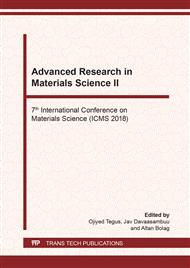[1]
Shin S.E., Choi H.J., Hwang J.Y, Bae D.H Strengthening behavior of carbon/metal nanocomposites, Sci Rep. 2015 Nov 6;5:16114.
DOI: 10.1038/srep16114
Google Scholar
[2]
Tjong S.C. Recent progress in the development and properties of novel metal matrix nanocomposites reinforced both carbon nanotubes and graphene nanosheets Mater. Sc. Eng. R74 281-350, (2013).
DOI: 10.1016/j.mser.2013.08.001
Google Scholar
[3]
Robles-Hernandez F.C., Calderon H.A. Nanostructured metal composites reinforced with fullerenes J. Minerals, Metals and Mater. Soc. 62 63-68, (2010).
DOI: 10.1007/s11837-010-0034-6
Google Scholar
[4]
Shpilevsky E.M., Penyazkov O.G., Filatov S.A., Shilagardi G., Tuvshintur P., Timur-Bator D., Ulam-Orgikh D., Modification of materials by carbon nanoparticles, Solid State Phenomena, 271 (2018) 70-75.
DOI: 10.4028/www.scientific.net/ssp.271.70
Google Scholar
[5]
Vityaz P.A., Shpilevsky E.M., Fullerenes in matrices of different substances, Journal of Engineering Physics and Thermophysics, 85-4 (2012) 780-787.
DOI: 10.1007/s10891-012-0714-x
Google Scholar
[6]
Shpilevsky E.M., Zhdanok S.A., Schur D.V., Materials containing carbon nanoparticles for hydrogen power engineering, in: Zaginaichenko, S.Y., Schur, D.V., Skorokhod, V.V., Veziroğlu, A., İbrahimoğlu, B. (Eds.), Carbon Nanomaterials in Clean Energy Hydrogen Systems – II, Springer Science, Dordrecht, 2011, pp.23-39.
DOI: 10.1007/978-94-007-0899-0_2
Google Scholar
[7]
Shpilevsky E.M., Shpilevsky, M.E. Shilagardi G., Electrical and thermoelectric properties of thin films of titanium-fullerene, vacuum technology, materials and technology, in: S.A. Vekshinsky, FSUE, Research Institute of Vacuum Technology, 2012, pp.111-115.
Google Scholar
[8]
Shpilevsky E.M., Shpilevsky M.E, Prylutskyy Y.I., Matzuy L.Y., Zakharenko M.I., Le Normand F., Structure and properties of C60 fullerene films with titanium atoms, Mat.-wiss. u. Werkstofftech, 42-1 (2011) 59–63.
DOI: 10.1002/mawe.201100732
Google Scholar
[9]
Zorin V.P., Kravchenko I.E., Shpilevsky E.M., Modification of fullerene C60 processes of adhesion of immune cells on the surface of materials, Low dimensional systems. Rel. 4, Grodno: Georgian State Univ., 2005, pp.50-54.
Google Scholar


